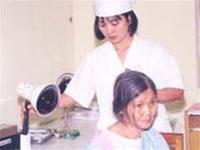Cervical Spondylosis: Common Condition Affecting the Neck
Cervical spondylosis is a common condition among people who frequently engage in activities affecting the head and neck area, leading to difficulties in daily activities and work for those affected.
When experiencing pain or limited movement in the neck, it is important to seek medical attention promptly to achieve the best treatment outcomes.
Who is at Risk for Cervical Spondylosis?
 |
| Using infrared lamps to treat pain caused by cervical spondylosis (Image: TTO) |
Cervical spondylosis is commonly seen in individuals who maintain a bent posture during work and frequently perform movements in the head and neck region, especially in high-intensity labor (working all day without breaks) and those with lengthy work experience. This condition can be found in rice planters (cervical and lumbar spondylosis), hairdressers, dental specialists, drywall workers, painters, and circus performers.
In older adults, the aging process of intervertebral discs and vertebral bodies, combined with poor blood circulation, makes them more susceptible to this condition than younger individuals. People with a family history of cervical spondylosis are also at a higher risk compared to those without such a background.
Symptoms of Cervical Spondylosis
Initially, patients may not notice any unusual sensations; however, symptoms may develop as follows:
– Neck movements may become restricted and painful, sometimes leading to a bent neck posture.
– Pain can radiate from the neck to the ears, shoulders, and arms, affecting head and neck posture, resulting in “torticollis” (twisted neck), with pain potentially extending to the head, causing headaches in the occipital and frontal regions, and discomfort that radiates from the neck to one or both shoulders and arms.
It is essential to differentiate cervical spondylosis pain from symptoms caused by conditions like posterior fossa tumors or benign tumors in the cervical spinal canal. Therefore, if unusual symptoms occur in the cervical spine, it is crucial to consult a neurologist for proper diagnosis and treatment direction.
With this condition, neck movements may be limited, and patients may experience difficulty turning their heads, stiffness in the neck, and localized pain when pressing on bony protrusions and transverse processes of the cervical spine. X-rays of the cervical spine may reveal loss of the normal curvature, narrowing of intervertebral discs, deformities in vertebral bodies, and bony spurs.
Cervical spondylosis at the C1-C2 level directly affects head rotation and holding. Degeneration at the C4 level can affect diaphragm movement. Damage in this spinal segment may also present symptoms such as hiccups, yawning, and dizziness.
To prevent fractures or dislocations that could lead to quadriplegia and increased mortality risk, it is essential to avoid twisting the neck or applying pressure to the neck. Patients should avoid sleeping with their heads elevated too high. Cervical spondylosis can potentially cause damage at the foraminal junction, affecting cerebral circulation. Therefore, patients should undergo neurological clinical examinations combined with modern diagnostic methods for timely detection and management.
Treatment for Cervical Spondylosis: For effective treatment, patients should rule out conditions such as occipital pain, shoulder pain, arm pain, and any surgical lesions like posterior fossa tumors or cervical spinal tumors. The main treatment involves using common pain relievers combined with therapeutic measures, including massage of the neck, face, and abdominal area. Additionally, taking vitamin E 400 IU, one capsule daily, is recommended. General functional rehabilitation of the entire body (especially for older adults) should include activities like relaxation and club participation.
As mentioned, this condition is significantly influenced by occupational factors. Thus, for circus performers and others whose work heavily impacts the neck and cervical area, it is essential to have massages and direct care for this region after each workday, avoiding excessive strain. A reasonable balance between work and rest time should be maintained, minimizing harmful impacts on the cervical spine. If symptoms of pain or difficulty in neck movement arise, early medical examination is crucial for optimal treatment outcomes.

















































